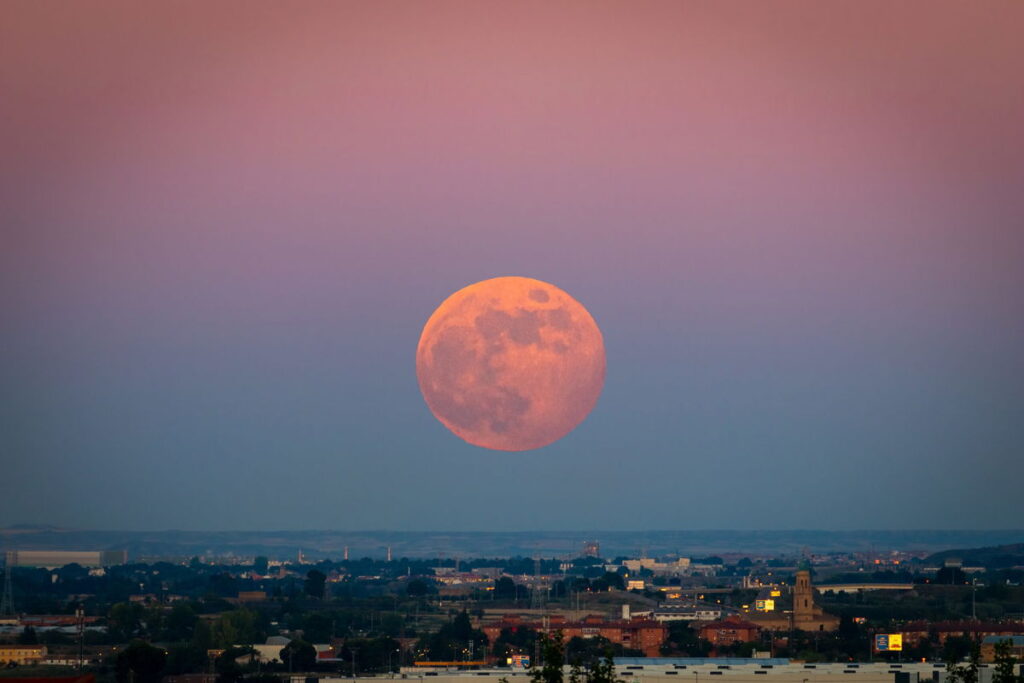
Total darkness reveals galaxies, clusters, and cosmic secrets above Spain. Strawberry moon rising: the juicy truth behind June’s lunar showstopper.Credit: Ivan Morato photography, Shutterstock.
Spain may be sweltering under a blanket of heat alerts, tropical nights and allergy explosions—but above the haze, the skies are putting on a dazzling show of their own. Forget your fan, grab your telescope—because June has something special in store.
Forget strawberries and cream – June’s skies are serving up a cosmic dessert of their own. Mark your calendars and ready your telescopes, folks – the famed Strawberry Moon is on the rise, and it’s ripening to perfection this 11 June at precisely 9:44am (peninsular time).
No, it won’t be pink, and no, you won’t need a basket – but this full moon comes with more folklore, astronomy and seasonal spice than your average midsummer night’s dream.
What’s the big deal about the Strawberry Moon?
June’s full moon – fondly dubbed the Strawberry Moon – isn’t just another pretty face in the night sky. It’s a seasonal signal fire. For the Northern Hemisphere, it traditionally marks the start of summer. Down south? It’s the chill bell for winter’s grand entrance.
But the real flavour of the name comes from Native American Algonquin tribes. Back in the day, this moon signalled it was time to harvest wild strawberries – hence the name. Across the globe, others called it the Rose Moon or Honey Moon – not because of colour, but for its romantic timing with midsummer weddings and sweet harvests.
The last proper Strawberry Moon – one that truly coincided with the solstice – happened decades ago. And the next one? Pencil in June 22, 2062, if you’re still around. That’s right – it’s a roughly once-every-50-years treat.
But wait, there’s more! June’s full lunar line-up:
This month, the moon doesn’t just shine – it struts through all four of its headline-grabbing phases. Here’s the full June 2025 lunar calendar, according to Spain’s Instituto Geográfico Nacional (IGN):
- First Quarter (Crescent): June 3 at 5:41am – under the sign of Virgo
- Full Moon (Strawberry): June 11 at 9:44am – lighting up Sagittarius.
- Last Quarter (Waning): June 18 at 9:19pm – swimming through Pisces.
- New Moon (No-show): June 25, at 12:31pm – hiding out in Cancer.
(All times are local for Spain’s mainland, Balearics, Ceuta and Melilla – check your region if you’re moon-watching elsewhere.)
Moon facts you didn’t know you needed
The moon doesn’t just go full, then vanish. It’s got a rhythm – a lunation, to be precise – that takes about 29.5 days to complete. That’s your average lunar month.
Here’s how it works:
- New Moon (Novilunio): Moon’s between us and the Sun. Zero glow. Pure ninja.
- Waxing Crescent to Full: She’s building up. Bit by bit, night by night.
- Full Moon (Plenilunio): Earth’s in the middle, moon’s fully lit. She’s giving you everything.
- Waning Moon: Time to pack up the party. The glow fades, heading back to dark.
Fun twist: If you’re moon-gazing from different hemispheres, the phases appear reversed. What looks like a right-side glow in Spain? A left-side light show in Argentina.
Bonus: Why the moon’s got a dark side (literally)
Scientists say there’s an internal anomaly behind the eerie difference between the moon’s two faces. The near side is smooth and familiar – the far side? Pitted, battered and mysterious. Think of it as the moon’s moody twin. Researchers suspect ancient cosmic collisions may have triggered the lunar lopsidedness. Not so far-fetched when you consider the moon’s violent formation history.
So, should you go outside?
Absolutely. Whether you’re a stargazer, a hopeless romantic, or just a fan of free entertainment, June 11’s Strawberry Moon is worth a peek. No telescope needed – just clear skies and maybe a bowl of strawberries if you’re feeling poetic.
Stay tuned to the Euro Weekly News for more Spanish news in English, just for you.
More Spanish living.







